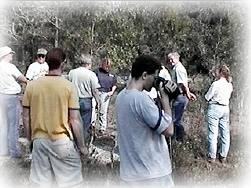
Field Group
Field Trip to the
Webb Wildlife Center
and Tillman Sand Ridge Heritage Preserve
Hampton and Jasper Counties, SC
October 22, 2000
| In conjunction with the Year 2000 Annual Meeting of the Gopher Tortoise Council (GTC), a field trip was conducted on October 22, 2000, to the Webb Wildlife Center near Garnett, SC (Hampton County). Steve Bennett and Wade Kalinowsky of the South Carolina Department of Natural Resources (SCDNR) described an ongoing radio telemetry project with Eastern Diamondback Rattle Snakes. After a tour of the study site and demonstration of radio telemetry, some participants continued with a guided tour of the nearby Tillman Sand Ridge Heritage Preserve (Jasper County, approximately 9 miles southeast of Garnett), which supports the largest and best-protected population of Gopher Tortoises in South Carolina. |
 Field Group |
The field trip began about 9:00 a.m. with participants assembling at the Webb Wildlife Center. There were 9 participants in addition to Steve and Wade. Yours truly was among them and I was excited about seeing the demonstration of radio telemetry tracking of snakes. |
| Most participants rode the open-air touring bench seats mounted on the truck which Steve drove. The conditions were quite dusty. Fortunately, I was able to commandeer the passenger seat in Wade's truck. We led the way, too! |  Tour Truck |
| As part of an ongoing study of the Eastern Diamondback Rattlesnake, Wade and other researchers keep daily tabs on the locations of specimens which have been implanted with radio transmitters. The transmitter consists of a small, hermetically-sealed cylindrical container which holds the electronics and battery. A wire antenna of 8 to 12 inches is attached. The transmitter is surgically inserted into the abdominal cavity of the snake. Each transmitter generates a specific radio-frequency signal. The frequency is used to identify the specimen. |
 Steve and Wade Start the Search |
Wade lead us to an area of mature pine forest similar to what once existed as natural Longleaf Pine Forest; however, most of the trees were now Loblolly Pines. We parked near yesterday's location for one of the study specimens. We were asked to remain near the trucks while Wade and Steve located the snake. |
| Using a handheld directional antenna, Wade setout to find the snake. From the frequency and amplitude of a series of chirping sounds emitted by the receiver, Wade was able to determine the snake's direction and estimate its distance. Within a matter of a couple of minutes, Wade had located the snake. It was only about 20 feet away from where I stood. | 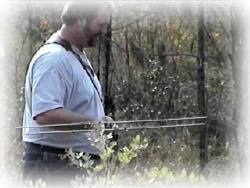 Wade Kalinowsky |
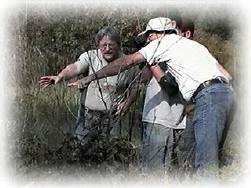 See The Diamondback Under The Bush? |
In order to not disturb the Diamondback, only two of us were shown the snake at a time. Of course the snake knew were were there; the idea was to let the snake believe we had not seen it. | 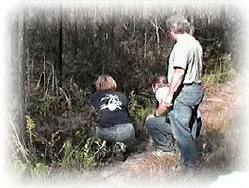 Yep. There it is. |
| The female snake was coiled beneath the branches of a scrub Sweetgum. Even though it was probably about 4 feet long, it was very difficult to see. It lay motionless the entire time we observed it. | 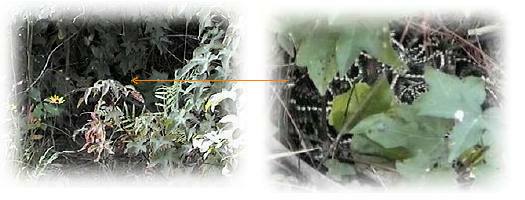 Hiding Place |
| We loaded back into the trucks and rode a short distance to another location. Wade and Steve located the snake about a hundred feet away in bushes just off a cleared pathway. They also spotted a roothole about 6 feet away which would probably serve as the snake's winter den. | 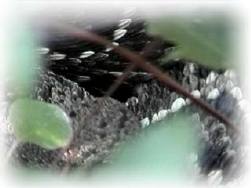 A Cryptic Snake |
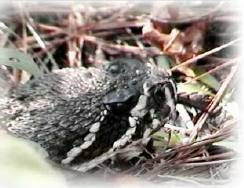 Doing the Cryptic Crawl |
This specimen was about the same size at the other. However, it was not as tolerant of our presence. After putting up with our intrusion for about 15 minutes, the Diamondback began a very slow crawl towards the den hole. Wade and Steve said this was a behavior they have observed often during the study. They called it the Cryptic Crawl. |
| The snake continued its slow crawl to the hole and then down into it. I used a negative exposure to capture her rattle just before disappearing into the hole. | 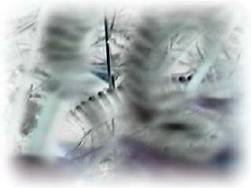 Last Look At The Rattle |
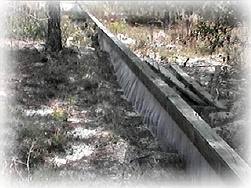 Gopher Tortoise Enclosure Fencing |
On the return trip to the Center's Headquarters, we were shown a facility providing a home for orphaned Gopher Tortoises. (Orphans are tortoises turned over to the SC DNR and whose origins are unknown.) The facility was an area of approximately 50 by 100 feet fenced with metal flashing. Native vegetation upon which the tortoises feed was being established within the enclosure. Steve said they planned to double the facility's size with the next year. |
| Our tour of the Webb Center was now over. Along with 3 other participants, I followed Wade to the Tillman Sand Ridge Heritage Preserve. | 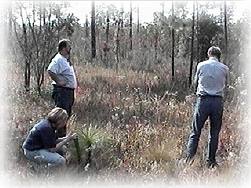 Terrain Within Tillman Sand Ridge Heritage Perserve |
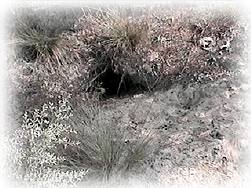 Gopher Tortoise Burrow |
We saw numerous Gopher Tortoise burrows, including some burrows of juvenile tortoises. However, we did not see any tortoises. |
| Although the continuing regional drought had left surface moistures very low, we found Hooded Pitcher Plants growing in abundance within a natural swale area. | 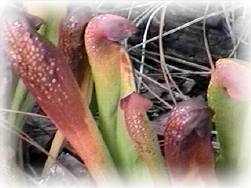 Hooded Pitcher Plants |
 9-Banded Armadillo On Highway Shoulder |
I believe that all who participated in the field trip join me in thanking Steve Bennett and Wade Kalinowsky for taking time out of their weekend to treat us to a great tour.
November 26, 2000 |